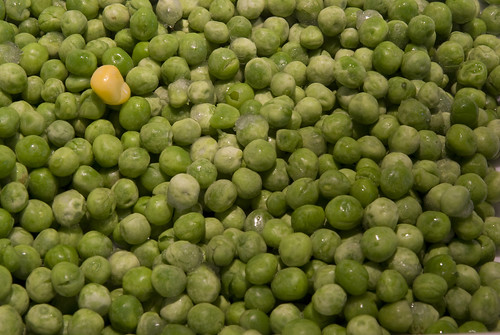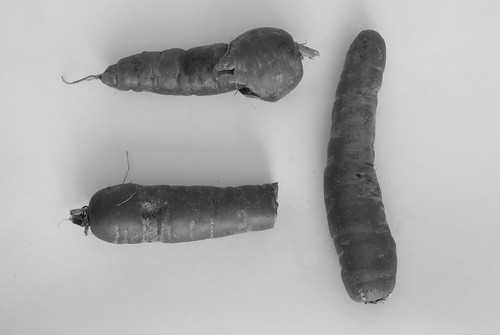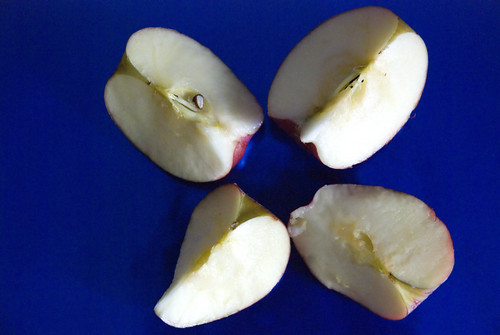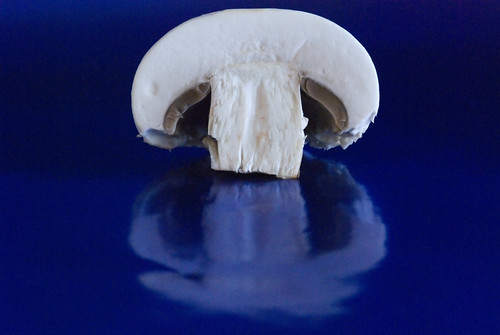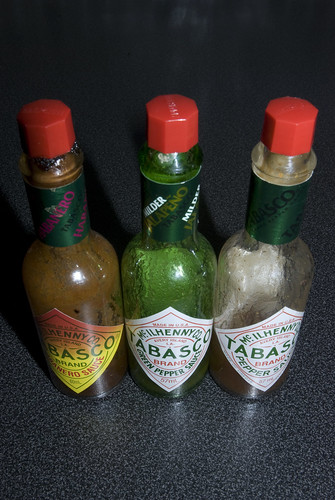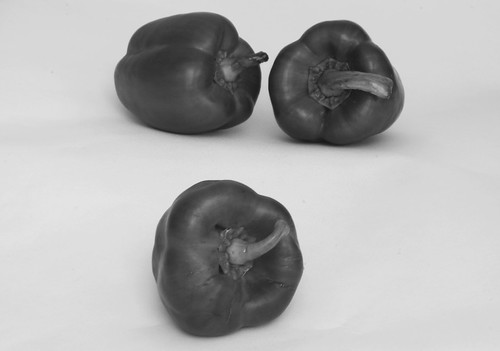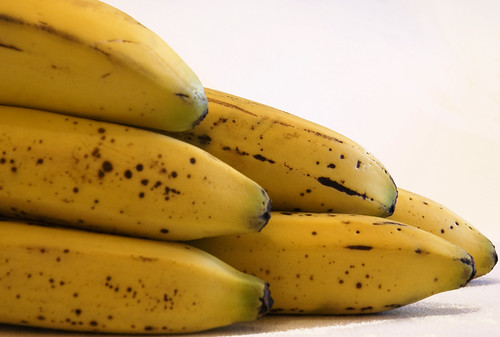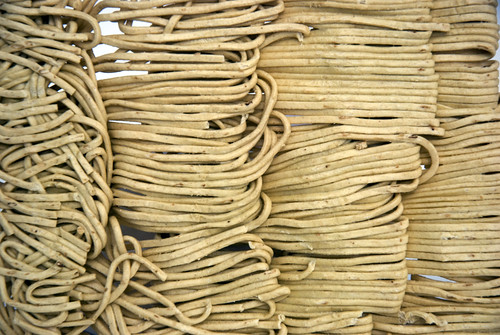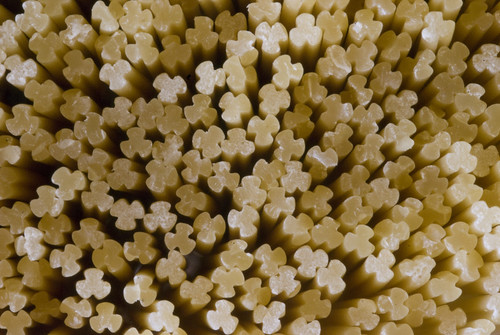Wednesday 17 November 2010
Tutor led visit to “Another World” Surrealist exhibition at the Dean gallery.
Both Dadaist and Surrealist art use symbolism, insect imagery, dream imagery, automatic writing, painting, drawing and photomontage. I was surprised to see that some artists used book illustrations from a previous age and used them as derivative art pieces to create new montages.
Some of the artists experimented with Automatic painting by placing objects over photosensitive paper and then placing them in the sun, as done by many very early photographers including “Robert Adamson” In a lot of these images, the extreme contrast between black and white made for stark images with intense shape definition. Other used Solarisation, the exposure of an image to sunlight during the developing process, to produce abstract images with less well defined shapes, whose edges draw the viewer’s eye in to the image in an attempt to construct the dark edges into everyday shapes.
I was surprised to see that one of the first exhibits we were led to was by Man Ray; up until that moment I was unaware of Man Rays work outside of the sphere of photography, we were shown “Man Ray 1914” the visual style of it reminded me of the use of light, shade and shape used by German Film directors and artists during “German Film expressionism”
As the tutor led us through these images, she mentioned Lee Miller who I had only heard of in passing at an exhibition on Vogue magazine photography and a single photograph by David E. Scherman of her sitting in Hitler’s bath in “The Great Life Photographers” I was very surprised to discover that not only was Miller a photographer herself, but of her involvement with a number of the artists in the surrealist movement not only on a professional level, but on a personal level. We were then given the opportunity for the group to split up and go off and examine, draw or study any of the pieces within the exhibition. I decided that I would like to wander around and see which of the exhibits drew my eye and made me think about them.
Among the works which were discussed I was attracted to a number of them on a personal level. I was drawn to “The Forest” by Max Ernst as it reminded me of slow shutter experimentation where the camera has been pointed at the lower trunks of some trees and then shutter has been fired and the camera moved up quickly before the shutter is closed, the same movement within the frame is caused by the lighter upward shooting lines from the dark bottom of the frame to the light top of the frame . It was not until I was looking at the painting for a few minutes that I spotted a green circle near the middle top of the frame which represents the sun.
In one room hang 10 pieces of art which are meant to be shown together, all these pieces by Man Ray simply use just primary, secondary colours along with black to form abstract layer shapes where two primary colours combined would produce a secondary colour. However where a secondary colour overlays a primary colour a different primary colour is produced e.g. orange overlay/interacts with red produced blue in one piece, this was not repeated in other pieces where the same interaction would produce a different primary colour or black. This interaction of colours is random and quite eye-catching. In some of the pieces there were wire frame shapes, some random, some organic and some geometric. This experimentation with wireframe geometric shapes also appears in the painting “aviary” where a geometric shape dominates the composition while not dominating the frame.
Alberto Giacometti - Head/Skull
I spent quite a long time studying the carving “Head/Skull” by Alberto Giacometti; by moving position around this sculpture I am presented with two interlocking fates. On one side a cubist face, the mouth open as if gasping for breath the eyes open staring forward into the middle distance. On the other side I am presented with a wide angular cheekbone of a skull, again the eye socket staring off into the middle distance, the angular jaw bone joining the mouth at the chin. On this side however I can see that the skull is locked inside the head and that one cannot exist without the other.
Leonora Carrington - Head
I was surprised to find that this painting by Leonora Carrington simply called “Head”
was not listed in the catalogue, this staring nightmarish face leers out of a haze of gray mist and swirls. Only the nose, the lower eye lids and the upper lip are defined. The eyes, irises white with small dark pupils stare out of the frame locking the gaze of the viewer, filled with anger and hate, the rest of the face and head dissipate starting with the cheekbones into the gray colourless mist. The imagery of the face leaning out of the mist was very attention-grabbing, it reminded me of a description of “DR Hyde” and even now the eyes from the image are stuck in my visual memory.
Salvador Dali - Exploding Raphaelesque Head
Dali’s Exploding Raphaelesque Head demonstrates Dali’s angst at the unleashing of the atomic age with the destruction of Hiroshima; The swirling disintegration and atomisation of the Raphaelesque head shows the artists fear that all creation, civilisation and art would be destroyed in an instant due to the immense power of the atomic bomb. I believe that I can see the formation of a mushroom cloud taking shape through the open cupola of the Pantheon; the force of the atomic disintegration ripping apart civilisation and art. The image can also be seen as a demonstration of Dali’s interest in the discovery of the atom and the scientific discovery that all things, pain, canvas and complete image are just vibrations of atomic particles. He plays with the idea that the image is flying apart as everything is basically made up of vibrating dots and wide spaces between the atoms.
Max Ernst - Sea & Sun
This painting split into two sections, one calm blue and white and the other reds, oranges and black mixed together with a black circle offset to one side. Could the lower portion of this painting be a sunspot on the surface of the sun? By 1925 when this painting was completed sunspots had been discovered and observed. The painting has a texture, within the frame caused by the movement of a comb over the surface of the painting; this comb has gathered some of the red and black paint from this lower portion and it has been transferred to the upper portion of the painting bringing a random chaotic rent to the calm surface. This rent also uncovers the red from a over painted section where a red diamond with a black dot peeks out from the reflected surface like a submerged object suddenly rising to the surface of a calm pond breaking the mirror like reflection.
Rene Magritte – Black Flag
In this image of dark blues, greys and blacks, nightmarish planes fly through the dark sky in a random chaotic formation. As soon as I viewed this image I was caught by the tension that these nightmarish creations should not be able to fly and that their rush to be airborne they are about to crash into each other, the implied movement in the image is that they are about to come together in front of the viewer. This I feel helps to create a sense of panic within the image, which is what the artist was trying to create as he was emotionally distressed by the night time bombing of a Spanish village by the German Air force in 1937.
At the point of time of painting the term black flag had already become a term of anarchy, as it represented a state of no country or no government a feeling that the Dadaist and the Surrealists would have supported as part of their own manifesto.
I enjoyed this Tutor led tour as it helped me to understand a lot more about the methods, principles and philosophies of the Dadaists and the Surrealists. I now understand better what they were trying to achieve when they created their works of art and I have found several pieces of art that I have a deeper understanding of.
Wednesday 10 November 2010
Exercise 25
Where: Gifford Church on the main corner of the village of Gifford, East Lothian
When: Between 11:00 and 11:30 on a bright, but cold winters morning.
How: First of all I had find a good position that I could set up on and where the light was not too bright on the outer wall of the church. The wall is south facing and the sun is low on the horizon.
I was expecting to see that the actual hue of the whole image would be affected by the white balance of the camera.
I decided that I would go beyond just the first couple of white balance settings and I went right through the full set available on the camera. When I returned home I uploaded the images from the camera and did a straight conversion of the RAW image into a JPEG without changing any of the settings from the camera.
AWB - Auto White Balance
I expected this shot to come out with a white balance which was well balanced. I expected to see white whites and blue blues.
D80,Aperture f/18, Shutter Speed 1/200 sec, ISO 320, 18mm (35mm equivalent 27mm), Pattern Metering Mode, Auto White Balance, Tripod Mounted, 18-70 lens.
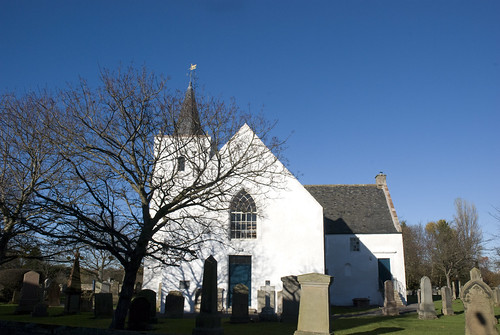
The Auto White Balance of the can have a mild affect on the image as the white was slightly golden with the low yellow sunlight. However the camera worked out the correct hue to apply to the image to stop it being too red or too blue.
Tungsten White Balance
D80,Aperture f/18, Shutter Speed 1/200 sec, ISO 320, 18mm (35mm equivalent 27mm), Pattern Metering Mode, Tungsten White Balance, Tripod Mounted, 18-70 lens.
From the notes I was expecting a very blue tinted image, and in this image the hue has been affected by the white balance setting.
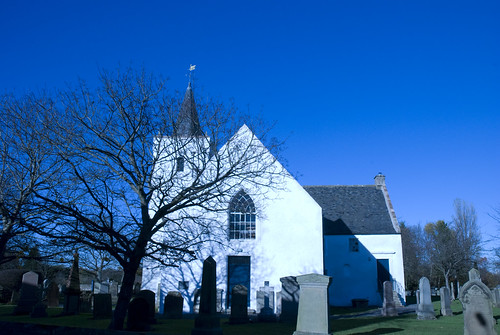
I was surprised to see how the hue of the grass was affected and how the blue made the colour darker and slightly more saturated. I can see from the white of the church how far the hue has been affected and how the blue of the door appears to be more saturated.
Fluorescent White Balance
D80,Aperture f/18, Shutter Speed 1/200 sec, ISO 320, 18mm (35mm equivalent 27mm), Pattern Metering Mode, Fluorescent White Balance, Tripod Mounted, 18-70 lens.
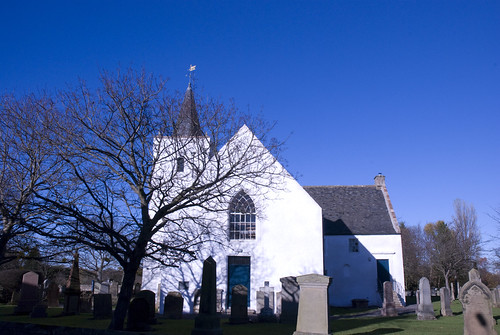
I was expecting from this shot an image which had a red hue to it. I was surprised to see that this white balance did not make the final image redder. I was expecting the white to be affected in the same way as the Tungsten White Balance and it to have a deeper red hue to the image. On deeper inspection I would see a red tingle to the white of the church.
Flicking between these first three images I was very surprised to see;
that the AWB had a slightly green hue to it
that the Tungsten White Balance had a blue hue to it and
that the Fluorescent White Balance had a red hue to it.
This is effect was the camera using one of the three primary planes of colour within the sensor (RBG) when influencing the image from the point of the selected white balance.
Fine Weather White Balance
D80,Aperture f/18, Shutter Speed 1/200 sec, ISO 320, 18mm (35mm equivalent 27mm), Pattern Metering Mode, Fine White Balance, Tripod Mounted, 18-70 lens.
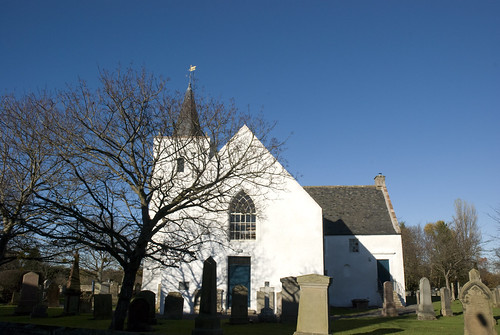
This white balance is almost the same hue and affect in white balance as the Auto White Balance.
Flash White Balance
D80,Aperture f/18, Shutter Speed 1/200 sec, ISO 320, 18mm (35mm equivalent 27mm), Pattern Metering Mode, Flash White Balance, Tripod Mounted, 18-70 lens.
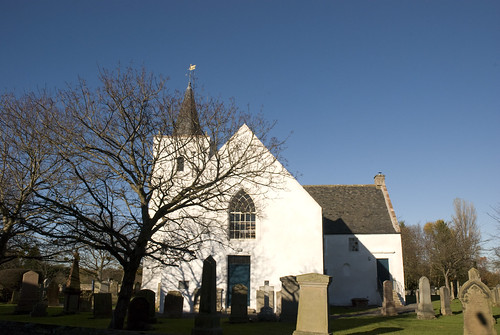
As the flash did not fire this white balance is purely based on the sunlight coming into the lens. Again this has a slight red hue to it, but not as much as the Fluorescent White Balance.
Cloudy Weather White Balance
D80,Aperture f/18, Shutter Speed 1/200 sec, ISO 320, 18mm (35mm equivalent 27mm), Pattern Metering Mode, Cloudy White Balance, Tripod Mounted, 18-70 lens.

I found it had to see a difference in hue to the Flash White Balance, if anything the hue was slightly red.
Shade White Balance
D80,Aperture f/18, Shutter Speed 1/200 sec, ISO 320, 18mm (35mm equivalent 27mm), Pattern Metering Mode, Shade White Balance, Tripod Mounted, 18-70 lens.

This white balance is affected by a slightly yellow hue to the image; this is caused by the Shade White Balance. I can clearly see in the branches of the trees that there is a yellow/red hue to the final image.
5000k White Balance
D80,Aperture f/18, Shutter Speed 1/200 sec, ISO 320, 18mm (35mm equivalent 27mm), Pattern Metering Mode, 5000k White Balance, Tripod Mounted, 18-70 lens.
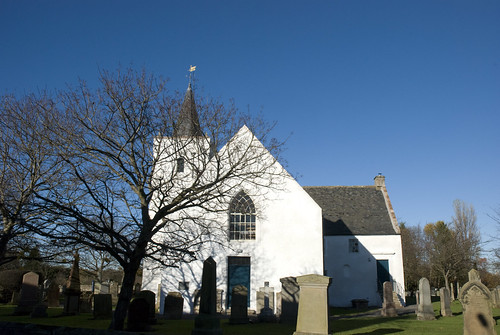
I was surprised to see that this White Balance had a slight blue hue to it. Having never used this White Balance setting before I was unsure what the final effect would be. The final image is again similar to the Auto White Balance
PRE (set) White Balance
D80,Aperture f/18, Shutter Speed 1/200 sec, ISO 320, 18mm (35mm equivalent 27mm), Pattern Metering Mode, PRE White Balance, Tripod Mounted, 18-70 lens.
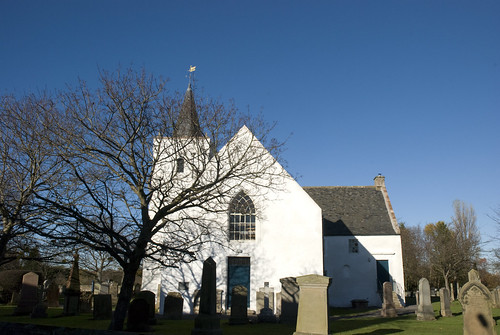
Having used a bridge camera before and used the PRE setting for white balance I knew that this would have little effect on the final image. It is mainly used in conjunction with a white or grey card to set the White Balance which is out with the preset White Balance available. It is used instead of the Auto White Balance to better control the colours and hues for the final images.
Looking at the thumbnails of the images after uploading them, I could see subtle differences in the hues between some of the White Balance Settings. Some were easier to spot while others were quite subtle.
All in all I was surprised to how far the hue of an image could be pushed by the settings on the camera, again this has shown that the colours can be controlled through and by the camera.
Wednesday 3 November 2010
Exercise 24
Where: Various Locations
When: On afternoon in dull overcast weather, the light was very grey and sullen.
How: First of all I had to read the text a couple of times to fully understand the that I had to use the camera to take a “normal average” exposure and then take 2 photographs where the subject was underexposed and two photographs where the subject was overexposed. Each under and over exposure had to be done by a half of one stop and then one full stop. I first of all made sure that my camera was in aperture exposure so at the start of the exercise I could double check the aperture and speed settings before moving the camera into manual mode. I then took the shot and then changed the aperture setting on the camera up and down to get the under and over exposure settings.
I had a good think about the brief of this exercise as I have been reading Johan Wolfgang von Goethe – The Theory of Colours and Johannes Ittens – The elements of Colour as I had wanted to refresh myself on colour theory, something which I have not really approached since my school days in Art class.
I was expecting to see that the brightness of the colours in the images varied with the exposure setting but not the saturation.
I also decided that I would go beyond just photographing a single image with differing aperture settings that the exercise specified as I wanted to see if different colours behaved differently, so I chose four different subjects to see if I could easily spot the differences at processing and writing up time. From reading the above books I knew that depending on the background of the image that the colour would vary.
I decided to first of all shoot a primary colour and see what happened.
Red Jersey
One stop underexposed.
D80,Aperture f/10, Shutter Speed 1/400 sec, ISO 320, 300mm (35mm equivalent 450mm), Pattern Metering Mode, Auto White Balance, Manual Mode, Tripod Mounted, 70-300mm VR lens.

Half a Stop Underexposed
D80,Aperture f/9, Shutter Speed 1/400 sec, ISO 320, 300mm (35mm equivalent 450mm), Pattern Metering Mode, Auto White Balance, Manual, Tripod Mounted, 70-300mm VR lens.

Average Exposure
D80,Aperture f/8, Shutter Speed 1/400 sec, ISO 320, 300mm (35mm equivalent 450mm), Pattern Metering Mode, Auto White Balance, Manual, Tripod Mounted, 70-300mm VR lens.

Half a Stop Overexposed
D80,Aperture f/7.1, Shutter Speed 1/400 sec, ISO 320, 300mm (35mm equivalent 450mm), Pattern Metering Mode, Auto White Balance, Manual, Tripod Mounted, 70-300mm VR lens.
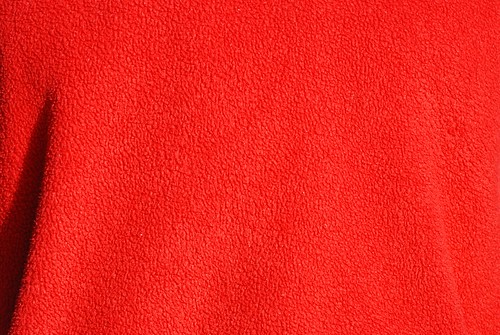
One Stop Overexposed
D80,Aperture f/6.3, Shutter Speed 1/400 sec, ISO 320, 300mm (35mm equivalent 450mm), Pattern Metering Mode, Auto White Balance, Manual, Tripod Mounted, 70-300mm VR lens.
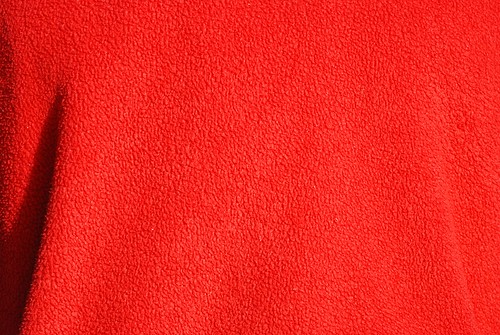
I then decided to shoot another primary colour which had a different hue and saturation level to it as I wanted to see if primary colours behaved in the same way when over and under exposed. I decided on the yellow grit bin as it was one of the brightest things in the surroundings
Yellow Grit Bin
One stop underexposed.
D80,Aperture f/10, Shutter Speed 1/200 sec, ISO 320, 140mm (35mm equivalent 210mm), Pattern Metering Mode, Auto White Balance, Manual Mode, Tripod Mounted, 70-300mm VR lens.

Half a Stop Underexposed
D80,Aperture f/9, Shutter Speed 1/200 sec, ISO 320, 140mm (35mm equivalent 210mm), Pattern Metering Mode, Auto White Balance, Manual, Tripod Mounted, 70-300mm VR lens.
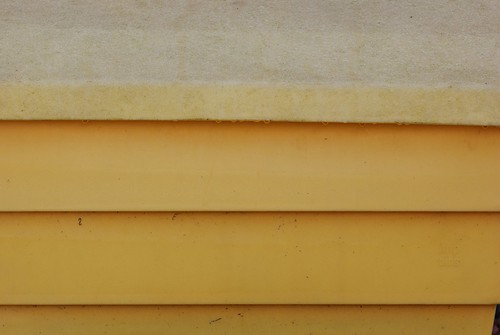
Average Exposure
D80,Aperture f/8, Shutter Speed 1/200 sec, ISO 320, 140mm (35mm equivalent 210mm), Pattern Metering Mode, Auto White Balance, Manual, Tripod Mounted, 70-300mm VR lens.
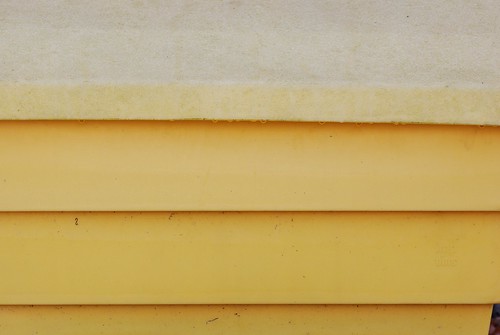
Half a Stop Overexposed
D80,Aperture f/7.1, Shutter Speed 1/200 sec, ISO 320, 140mm (35mm equivalent 210mm), Pattern Metering Mode, Auto White Balance, Manual, Tripod Mounted, 70-300mm VR lens.
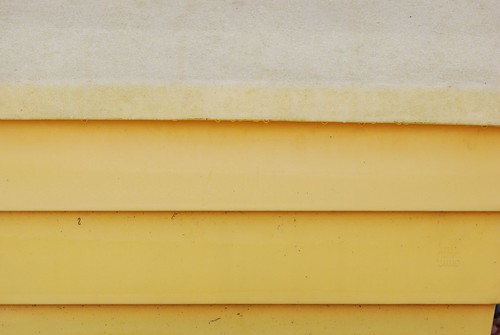
One Stop Overexposed
D80,Aperture f/6.3, Shutter Speed 1/200 sec, ISO 320, 140mm (35mm equivalent 210mm), Pattern Metering Mode, Auto White Balance, Manual, Tripod Mounted, 70-300mm VR lens.

I could see from the thumbnails of the images that the red example was slightly better defined in the range of colour due to the exposures, I could see that the colour became brighter but lost none of its saturation. The yellow example was a little harder to spot the differences.
I then decided to photograph an orange Physalis as I wanted to see what secondary colours would do under the same conditions. I was drawn to the Physalis as I knew that light penetrated the subject and it thought it may differ in brightness and saturation due to it being almost back light. I expected that the light coming through the subject due to its transparency would destroy most of the detail of the subject when overexposed.
Orange Physalis
One stop underexposed.
D80, Aperture f/18, Shutter, Speed 1/60 sec, ISO 320, 300mm (35mm equivalent 450mm), Pattern Metering Mode, Auto White Balance, Manual Mode, Tripod Mounted, 70-300mm VR lens.

Half a Stop Underexposed
D80, Aperture f/16, Shutter, Speed 1/60 sec, ISO 320, 300mm (35mm equivalent 450mm), Pattern Metering Mode, Auto White Balance, Manual, Tripod Mounted, 70-300mm VR lens.

Average Exposure
D80, Aperture f/14, Speed 1/60 sec, ISO 320, 300mm (35mm equivalent 450mm), Pattern Metering Mode, Auto White Balance, Manual, Tripod Mounted, 70-300mm VR lens.
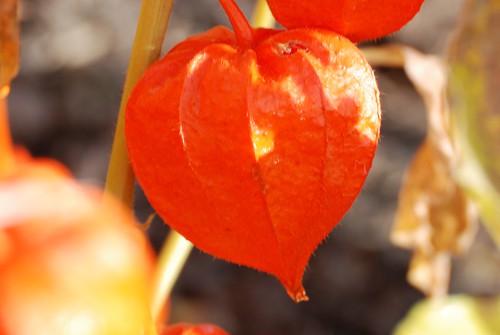
Half a Stop Overexposed
D80, Aperture f/13, Speed 1/60 sec , ISO 320, 300mm (35mm equivalent 450mm), Pattern Metering Mode, Auto White Balance, Manual, Tripod Mounted, 70-300mm VR lens.

One Stop Overexposed
D80, Aperture f/11, Speed 1/60 sec, ISO 320, 300mm (35mm equivalent 450mm), Pattern Metering Mode, Auto White Balance, Manual, Tripod Mounted, 70-300mm VR lens.
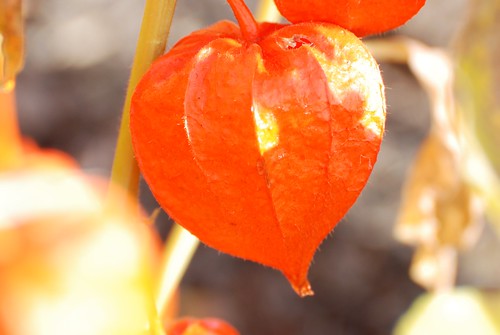
I was surprised to see that the back lighting of the subject did not make it become too washed out and loose all its detail when overexposed. I thought that it may have become lost in a bloom of orange white and I was very suprised to see that it retained details as well as some of its colour
Finally I wanted to see what would happen to white when under and over exposed, I wanted to see if the white would become grey when under exposed and when overexposed the subject would quickly lose all detail within one stop and become very bright and blown out.
One stop underexposed.
D80, Aperture f/29, Shutter, Speed 1/200 sec, ISO 320, 220mm (35mm equivalent 330mm), Pattern Metering Mode, Auto White Balance, Manual Mode, Tripod Mounted, 70-300mm VR lens.

Half a Stop Underexposed
D80, Aperture f/25, Shutter, Speed 1/200 sec, ISO 320, 220mm (35mm equivalent 330mm), Pattern Metering Mode, Auto White Balance, Manual, Tripod Mounted, 70-300mm VR lens.
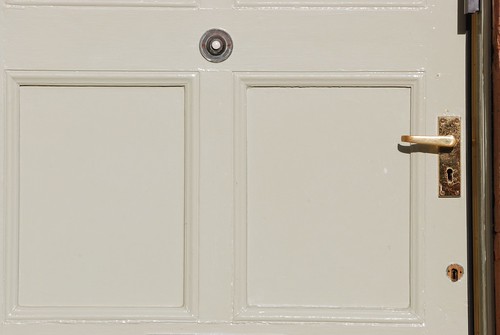
Average Exposure
D80, Aperture f/22, Speed 1/200 sec, ISO 320, 220mm (35mm equivalent 330mm), Pattern Metering Mode, Auto White Balance, Manual, Tripod Mounted, 70-300mm VR lens.
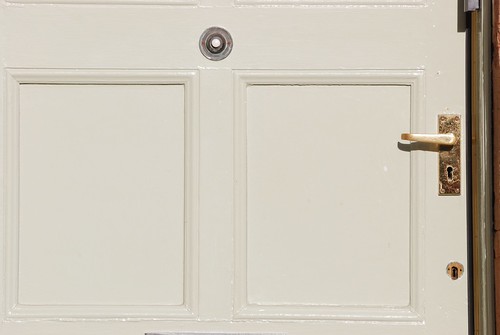
Half a Stop Overexposed
D80, Aperture f/18, Speed 1/200 sec, ISO 320, 220mm (35mm equivalent 330mm), Pattern Metering Mode, Auto White Balance, Manual, Tripod Mounted, 70-300mm VR lens.

One Stop Overexposed
D80, Aperture f/16, Speed 1/200 sec, ISO 320, 220mm (35mm equivalent 330mm), Pattern Metering Mode, Auto White Balance, Manual, Tripod Mounted, 70-300mm VR lens.

Again just looking across the thumbnails of the images I could quickly how much of a difference it made in the appearance of the colour just by choosing an exposure. I was suprised to see how much of a difference in the colour of a white door could be made to differ just through exposure.
As I was writing up this exercise I referred back to the notes paying attention to the examples for saturation and brightness as I did not want to confuse the two concepts as I had already made that mistake when I first looked at the range of colour from each selection of images that I had taken.
This was quite an interesting exercise; as it verified some of the points in the books I am reading, it also showed that the colour of a subject could be varied and influenced by under or overexposing the image. This means that the colour of a subject can be controlled to a certain extent by the camera and the photographer.
Thursday 30 September 2010
Assignment 2 – The Elements of Design
What: The brief of this assignment was to incorporate the insights learned so far on the course and produce a set of at least 10 images directed towards one type of subject.
Where: In the house using various tabletops and counters as shooting locations.
When: The photographs were taken over multiple days using differing locations and light sources.
How: First of all I had to read the text a couple of times to fully understand the brief of the Assignment. As I progressed through the assignment I made notes in my daybook in the style of a diary. I also included in the daybook some drawings and diagrams on some of the concepts that came to mind after reading the text. I will include these notes and concepts in this assignment paper.
I looked through the choice of subjects available and decided on elements of food as the subject that I would use for my brief, food is something which is close to my heart as I enjoy cooking as it helps relax me at the end of a day.
One of the first ideas I thought about was the triangle and pyramid shapes made by a bunch of bananas; I thought about a white background and then stacking up the bananas so that the dark ends of the bananas formed a triangle, this along with a long depth of field showing the bananas bending off into the distance.
I started to think about citrus fruit and the shapes that can be made from them by cutting up the fruit in different directions to the segments of the fruit. Stacking apples into a triangle shape also quickly came to mind but I decided to reject the idea on the basis that it may be a little clichéd.
While working in the kitchen I could examine each ingredient as I used it with the brief in mind.
Looking down at the ends of a handful of dried spaghetti, I hit on the idea of using a macro end on shot of the spaghetti ends which would produce the concept for Pattern.
I also considered black or coloured peppercorns, lines in flour or rice, stacking tins to produce a triangle or a cup very closely at a wide angle. I also considered a knife edge for lines. Some of these Ideas I tried out and some I never carried forward from the initial idea, not because they were poor ideas and concepts rather that I went in a different direction with another idea.
The first Image Single point dominating the composition; One of the first ideas I had for this composition was that I wanted a single egg yolk on a plain black background. I was considering using a black square plate for the background of the composition but found that it was too glossy and that the plate had a deep curve which stood out when any light hit the plate.
In the final composition I wanted the background to be very much a pattern going in all directions and that the single point should be on one of the intersections of one of the lines in the rule of thirds. With this in mind I used a single yellow corn on a background of green peas. I carefully placed the corn on the peas and then looking through the camera viewfinder I adjusted the position of the corn until I was happy with the final composition. The main source of light was two halogen lights above the composition.
I slightly cropped the image in Photoshop to remove some of the extraneous background which was unnecessary.
01. Single point dominating the composition; Nikon D80, focal length 70.0mm (35mm equivalent 105mm), aperture f29.0, speed 1 second, ISO 200, -1 step on the exposure, auto white balance, matrix metering, tripod mounted camera, No flash.
I am quite happy with the final composition as it does quite clearly show that the corn is the single point dominating the rest of the composition; it does draw the eye to point.
The second image Two points; At first I went with two eggs in eggcups positioned away from each other diagonally across the frame, however the composition when viewed and thought about did not really work out as the eggs were too close a colour to the wooden board which was acting as the background. The other problem was that the eggcups themselves were dominating the composition due to their colour. As this was not within the brief I quickly dropped that idea. After thinking about the composition for an hour or two, I changed my mind and quickly rehashed my idea of an egg yolk being a point within a composition, however this time I would include either another yolk, possibly cooked or, as in the final composition, a piece of egg shell. After breaking a couple of eggs I chose a piece of shell and gave it a rinse in cold water to remove the gloss from the shell and to basically clean the shell of any remaining egg white. I then placed the piece of shell in a position and photographed a couple of different shots where the shell was either in a different position or in a different orientation. In the end I liked the position and orientation of the shell, but it would not sit in position, and I had to use a small piece of corn behind the shell to support it and allow the orientation and position that I wanted. I then spent some time gently cleaning the yolk to remove bubbles of egg white which were in the way.
Again I cropped the final shot slightly as there was a small space at the corner of the glass sheet in the far right corner which was drawing the eye away. This crop also allowed me to tighter up the composition and makes it appear as if the shell and yolk were closer together. The light source for this photograph was from two halogen bulbs in a cooker hood above the board and surface.
02. Two Points; Nikon D80, focal length 62.0mm (35mm equivalent 93mm), aperture f29.0, speed 1.5 second, ISO 200, auto white balance, matrix metering, tripod mounted camera, No flash.
I’m much happier with this final composition as the two points relate in balance making for a very strong composition and there is a narrative and relationship between the yolk and the shell. I wanted a long depth of field for this photo to allow all the parts of the two points to be seen and be clear.
The third image Several Points in a deliberate shape; I went back to the workbook notes and looked over them as I wanted this composition to be clear in my mind. After thinking about using grapes, dried fruit I decided on using some vegetables. I laid out a white paper background on a table and experimented with different layouts making different shapes. I really wanted a clear shape, so I went with an elliptical circle as this draws the eye around it. I had chosen a wide range of items and I knew that I just had to look at the setup and keep swapping items in and out of the composition until I had the shape that I wanted.
As I sat looking at the composition I noted that there was too much light coming in the window and this was casting long shadows on the subjects. I closed the curtains. While this pushed the exposure speed down to 2 seconds it did not fully reduce the shadows and I then switched off all the surrounding lights, this pushed the exposure speed down to 10 seconds but it also stopped the long shadows being cast which pulled the eye away from the composition.
03. Several Points in a deliberate shape; Nikon D80, focal length 29.0mm (35mm equivalent 43mm), aperture f25.0, speed 10 seconds, ISO 200, auto white balance, matrix metering, tripod mounted camera, No flash.
While this is a very simple composition, the shape is deliberately simple, I am not fully happy with this image as I found that it was a little clichéd. However it fitted the brief and I am particularly pleased that I managed to use a bend carrot as this moves the eye through the composition. It almost looks like a guiding pointing arrow.
The fourth image A combination of Vertical and Horizontal lines; when I started to think about this composition I started to think about a grid of intersecting lines and I had the notion about using spaghetti, corn on the cob, spring onions, leeks, ends of bread or toast soldiers. My first basic idea for the composition was to make a grid of spring onions and looking straight down shoot the image from directly above the subject.
It was while I was working on another composition that I noticed that I had a few left over carrots, I then decided to use them as the subject for the image. I noted that the surface of the carrots themselves had horizontal lines running across them I then experimented with a few layouts of the carrots shooting each composition and combination and then looking at the image on the back of the camera. I decided on the final layout and with a little tinkering with the carrots themselves I shot two exposures of the image, one with the curtains open letting in some sunlight in combination with overhead light and the second exposure I closed the curtains and switched off the lights, this made for a very long exposure of 15 seconds which was a great difference to the first which was shot at 1/200th of a second. When I looked at the images on the screen I liked the longer exposure as it had a bit more character to the image and the carrots were not overbalanced by their shadows. Once I viewed the image on my PC screen I changed the image from colour to monochrome and I could see that the carrots had further definition on them and that they themselves had horizontal lines when view vertically and vice versa, this was what lead me to use this as the fourth image.
04. A combination of Horizontal and Vertical lines; Nikon D80, focal length 52.0mm (35mm equivalent 78mm), aperture f29.0, speed 15 seconds, ISO 200, auto white balance, matrix metering, tripod mounted camera, No flash. Converted into B&W in Photoshop
I am pleased with this final composition as the carrots are presented using the rule of thirds and the unusual shape of the carrots is further defined by the use of black and white rather than colour.
The fifth image Diagonals; at first I could not think of a definitive image that I could produce for Diagonals and for a few days it was one of the shots that eluded me. At first I was going to use a large watermelon and photograph the end of it, where all the lines come together, however I could not find a watermelon which was not either battle scarred or had a dark circle at the end of it. Again I went back to the idea of citrus fruits and I considered the diagonal lines created when a fruit is sliced in half and the segments all meet together in the middle, in a kind of faux perspective. I was not too happy with this idea in the end and I finally went with the split apple. I found that if I split the apple and arranged it that I could have diagonal lines at the centre of each section of apple, the diagonal lines as each segment lined up with its opposite part, a square and a circle all within the same composition. I used the blue background to allow the apples to stand out. The background paper was very shiny so I could not use a flash otherwise the middle section of the composition was just a mass of blown out white.
05. Diagonals; Nikon D80, focal length 70.0mm (35mm equivalent 105mm), aperture f7.1, speed 1/50th second, ISO 3200, auto white balance, matrix metering, tripod mounted camera, No flash.
To achieve the overhead shot, I had to dismantle the tripod and use the central section as a boom arm; this made taking the shot difficult as any movement caused the camera to bounce. I got round this by using an IR remote to trigger a countdown on the camera before it fired the shutter, this allowed me to position and adjust the camera, check the framing and then allow the camera to stop moving before I took the shot , I was not sure at first about the definition of the apples, but I was not too concerned as it was more important that the definition of diagonal lines were present. I think that I lucked out with the final composition as the apples still look nice and I have the lines and shapes in the final composition.
The sixth image Curves; I had a bit of fun with, as I just ran mad with ideas for differing compositions for the image. I considered amongst other things, a stack of dried apricots, onion slices, cob lettuce, Chinese leaf lettuce (both sliced across the way) and a pile of apple skin. I also considered biscuits but decided that they may be out of the scope of the brief!
I set my mind on using the apricot skins, until I saw the film Hard Boiled. During one scene an actor was talking and while he did this he peeled an apple. The coils of skin just drew my eye and I decided on the use apple skin which had been removed in one long spiral; I planned to hang it up on a piece of cotton thread and photographed it against a pale background. In the long term I was not happy with the way that the apple skin hung, so I went with orange skin but in a coiled pile on a tabletop. I placed the orange skin on a white background to help define the skin and used a very straight on perspective to the orange skin. This produced quite a weak composition so I moved the camera up a bit and recomposed from a slightly higher angle. This helped to define the curves in the skin and I was much happier with the image.
06. Curves; Nikon D80, focal length 70.0mm (35mm equivalent 105mm), aperture f4.5, speed 1/200th second, ISO 200, flash white balance, matrix metering, tripod mounted camera, Flash was fired but auto controlled by the camera
The final composition easily demonstrated the curves created in the orange skin and the white background did not wash out the orange pith. I’m not 100 percent happy with the background as the top left hand corner was a little darker than the rest of the image. I considered lightening it using Photoshop but I thought that this would be artificial enhancement of the image and cheating, so I left it as is.
The seventh image Distinct if Irregular shape; for this I threw a large handful of dried fruit and nut mix down onto a tabletop. I did this a couple of times until I achieved a truly random shape and not a clump of fruit. This produced quite a number of irregular shapes, but it was not until I was checking the images off the printer that I began to feel that this was not what was wanted and that it was a particularly weak image.
I sat back from it and looked at it pinned on the wall and I was not happy with the image. I then decided that I would have to reshoot it another day.
I thought of a mushroom as it was an irregular shape but it was also distinct, I then sliced a mushroom in half and had a good look at it, I noted that the shape itself was spoiled by the top skin of the mushroom and I then peeled the skin from it. This helped to further define the shape I then placed it onto the blue shiny paper background as this was an excellent contrast to the colour of the mushroom and set up the camera and tripod for a macro shot.
As I composed the macro shot I pulled the camera and tripod back a little so that I could get both the mushroom and it’s irregular reflection within the frame.
07. Distinct if Irregular Shape; Nikon D80, focal length 105mm (35mm equivalent 157mm) using a Macro Lens, aperture f13, speed 1/4th second, ISO 3200, auto white balance, matrix metering, tripod mounted camera, No flash.
After viewing the image on screen I decided to remote a little of the gain of the high ISO by using Neat Image as this did not change the colour, shape or definition of the final image, it just removed some of the grain caused by the Nikon cameras high ISO.
I am very pleased with this as the final image as both the colour and the reflection work for the composition. The shape of the mushroom is clear and well defined against the blue background and it almost looks like it is reflected in water.
The eight, ninth tenth and eleventh images Implied Triangles; I had a number of ideas that I experimented with for this brief. I had to produce at least two types of implied triangle for the brief and I chose to do one which would be a triangle produced by perspective and the other would be an implied triangle through positioning of items.
The first of these is the implied triangle by perspective. I started by placing three bottles together in two lines with the first in front of the other two, but this made up a real triangle when viewed from a high point of view using a wide angled lens. I then swapped to just two bottles and recomposed again with a high point of view for position, this made for a very centre heavy compostion, so I added the third bottle back in again but this time inline with the other two and I then recomposed on a tighter view of the bottles and using a wide angle lens this produced an implied triangle in shape.
08. Implied Triangle; Nikon D80, focal length 31mm (35mm equivalent 46mm), aperture f25, speed 1/60th second, ISO 3200, auto white balance, matrix metering, tripod mounted camera, No flash.
It was after I had printed a proof of the image that I noted that the implied triangle was not too clearly defined and that it may not be the strongest image to portray an implied triangle. I have not discarded it all together but submitted it along with a third implied triangle image.
Implied triangle number two; using the course notes for inspiration I setup this shot , I used some items behind the background to create a two step layer so that the back level was higher. I then laid out the two peppers on the higher step and the third on the lower step. I changed the orientation of the peppers until I was happy with the composition and photographed it.
09. Implied Triangle; Nikon D80, focal length 65mm (35mm equivalent 97mm), aperture f29, speed 28 seconds, ISO 200, auto white balance, matrix metering, tripod mounted camera, No flash. Converted into B&W in Photoshop
10. Implied Triangle; Nikon D80, focal length 65mm (35mm equivalent 97mm), aperture f29, speed 28 seconds, ISO 200, auto white balance, matrix metering, tripod mounted camera, No flash.
Once the image was on the computer I post processed the image to see how it would look in monochrome, I could not choose which version was the better version so I decided that I would submit them both but as one shot rather than two separate items.
Implied triangle number three; After proofing the image with the bottles, I decided that it may not portray the concept of an implied triangle, so I setup this third implied triangle shot. Like a few of my other shots for this brief I have gone back to an original idea and adapted it for another concept. In this case I liked the idea and colour of the bananas and I thought that they would work well as an implied triangle. As previously stated I was looking at ends of the bananas but I kept thinking that they produce a real triangle rather than an implied triangle. I then moved the board around examine the framing and composition until I hit on this shot.
11. Implied Triangle; Nikon D80, focal length 70mm (35mm equivalent 105mm), aperture f11, speed 0.8 seconds, ISO 400, auto white balance, matrix metering, tripod mounted camera, No flash.
I liked that fact that the bananas sweep into the frame from the left and end in the implied triangle due to the different lengths of banana. The shape formed is not quite so much of a real triangle, more of an implied triangle. There is also a little rhythm in the green and back ends of the bananas. I like the colour and the shape that the stack of bananas makes and the movement through the frame.
In the twelfth image Rhythm; again I went back to the course notes and looked at various different foods that i had in the kitchen. I liked the idea of using dried noodles because just like the dried spaghetti, they look different when dried as to when they are cooked. I liked the way that the noodles were stranded together and that the noodles repeated both across and down the tray of noodles. I balanced them on the long end of the noodles and photographed them trying to get as close as I could to the entire tray without either leaving too much outside the frame.
12. Rhythm; Nikon D80, focal length 70mm (35mm equivalent 105mm) aperture f13, speed 1/3rd second, ISO 200, auto white balance, matrix metering, tripod mounted camera, No flash.
I liked this image as it has a relationship between the tension and the looseness of the dried noodles. I also like it as my eye flows around the image following the repetitive shape and flow.
In the thirteenth image Pattern; I had quickly hit on this idea after looking at some spaghetti, after looking down at the ends of a handful of dried spaghetti, I liked the idea of a macro shot end on shot of the spaghetti ends as this would show the strange shape of the spaghetti strands. This was quite a simple setup and image to photograph. I just held enough dried spaghetti together with an elastic band and using a macro lens on the camera just moved the tripod closer to the ends so that the spaghetti was the only this visible in all directions. Also by using the macro lens I got a bit of perspective looking along the length of the spaghetti strands.
13. Pattern; Nikon D80, focal length 105mm (35mm equivalent 157mm) using a Macro Lens, aperture f57, speed 10 seconds, ISO 800, auto white balance, matrix metering, tripod mounted camera, No flash.
I am really happy with this image as it just came together really easily. I liked the original concept and it was quite an easy photograph to take as it just all sat together nicely.
I have found this assignment a bit of a challenge as it forced me to concentrate on one subject. This allowed me to experiment with different angles and composition techniques to obtain an image that I was happy with. There are some things I have learned quite quickly and I used them throughout the assignment.
Don't Panic - keep looking and thinking. If an idea does not work, ask yourself if the idea or composition can be reworked to make it better suit another part of the brief.
Don't be satisfied with the first shot. I have started to examine the composition before and after taking the image, as there may be a better way to present the subject or there may be a small item which pulls the eye away
Prepare and adapt - keep working the idea, work slowly, confidently and (again) do not be satisfied until the image is captured in the camera.
Tripods and other equipment are just tools, not a sign of weakness in composition.
Document and log everything because you might just need that idea again.
Thursday 16 September 2010
Update - Working on Assignment 2
Already I have thrown away a few ideas as they have not worked out in reality, epsecially when small items that I had not considered throw the whole composition off.
Things I have learned so far
- Don't Panic - keep looking and thinking. If an idea does not work, can the idea or composition be reworked to make it better suit another part of the brief.
- Don't be satisfied with the first shot - I have started to examine the compositon before and after taking the image, as there may be a better way to present the subject or there may be a small item which pulls the eye away.
- Prepare and adapt - keep working the idea, work slowly, confidently and (again) do not be satisfied until the image is captured in the camera.
- Tripods and other equipment are just tools, not a sign of weakness in composition.
This has been good fun, so far and I am enjoying the challenge of creating the images and working through ideas.
Sunday 12 September 2010
Exercise 23
Where: Various Locations near a local coal fired power station
When: On afternoon in dull overcast weather.
How: First of all I had to read the text a couple of times to fully understand the difference in the principles between rhythm and pattern.
As I can understand it rhythm is where the image contains a form of movement within the image and pattern is where the image is more static and does not contain much movement.
I had a good think about the brief of this exercise and thought about differing styles including macro photography both in the house and outside. However I decided on photographing outside and went to a location that I knew near by, which was a local coal fired power station. I knew that I would find a location within this area which would be suitable for at least one of the two requirements of the brief.
Rhythm
I was looking for a strong image for this exercise; I looked for something which was both unusual and eye-catching. At first I wanted to use the repetitive design of the stations glass front, however once I was set up and looking at the building that I found that the composition did not work. I then walked around the entire station to see if I could find a better composition. It was during this walk down that I spotted the stairway going down the side of building. It had lots of repeating features and was while looking through the viewfinder that I found that I was happy with the composition.
It was not until I was back at the PC that I realised that there were a couple of men working on the floors almost at same distance apart from the stair railings. I also liked the repetition of the lights, the doors, the windows and the actual shape produced by the corrugated material making up the building.
I think this is quite strong for rhythm as the rhythm goes in both directions, both across the image as well as down the image. The men working on the floor help to establish the scale of the area.
I did crop the image down slightly to better establish the framing and composition of the image as there was a small imperfection at the top and bottom which took the eye away from the rhythm of the image.
D80,Aperture f/16, Shutter Speed 1/80 sec, ISO 640, 270mm (35mm equivalent 405mm), Pattern Metering Mode, Auto White Balance, Aperture Priority, Hand Held, VR lens.

Pattern.
I was thinking about using rain drops on a window for this image but it did not rain at a convenient time for me to establish a good quality shot. I also spotted a pattern in birds flying above fields being harvested, but in this case I was on a motorway and could not stop, plus I did not have my camera!!
In the end I decided to produce two images which convey pattern. I’m not sure about the first image as I am not sure that it the boundaries are good enough to convey pattern as they have a small hole which drags the eye off to the bottom left.
D80,Aperture f/4.5, Shutter Speed 1/640 sec, ISO 640, 92mm (35mm equivalent 138mm), Pattern Metering Mode, Auto White Balance, Aperture Priority, Hand Held, VR lens.
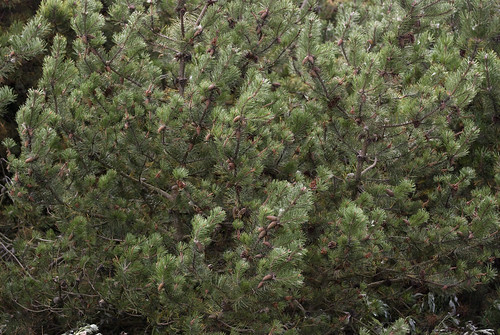
When I started to think about this exercise I was set against photographing a brick wall, I thought that it would be a bit of a cop out. However when I saw this wall I decided to sit down and have a look at it before I disregarded it. I was looking through the viewfinder and I experimented with this brick pattern; I used different distance and framing before deciding on this tight close up of the bricks. I like the fact that there is a small differing pattern running through this image on the small end of the bricks. I also like the different colours of the bricks.
This is actually a brick bench and windbreak built on the hill beside the power station probably at the time the station was built unfortunately it has seen better days.
D80,Aperture f/7.1, Shutter Speed 1/400 sec, ISO 640, 185mm (35mm equivalent 277mm), Pattern Metering Mode, Auto White Balance, Aperture Priority, Hand Held, VR lens.

This part of the course has been very interesting as I started to see these elements of design all over the place. It has also helped me examine other photographers and artists work and has allowed me to see the same principals in their work. In some cases it has allowed me to understand better what I like about the image. Again this exercise has reinforced the principles of composition and design.
Now I have to produce the images for Assignment 2.
Saturday 28 August 2010
Further Learning - Edin. Uni Open Learning - Edinburgh's Photographers D O Hill and R Adamson
The course summary is that in 1840s Edinburgh the unlikely partnership of David Octavius Hill and Robert Adamson produced photographs which have been admired ever since as among the greatest achievements of photography. The course looked at the reasons for the success of the partnership and the images they made and how these were influenced by the Edinburgh in which they lived.
David Octavius Hill was a well established landscape and portrait painter in the Victorian period before he was persuaded by his friend the physicist and philosopher David Brewster to meet with Robert Adamson at Adamson’s studio in Rock house of Calton hill. Brewster moved within the enlightened circles of Edinburgh's society and was a member of the “Dilettanti club” a varied group of individuals comprising amongst others poets, engineers, painters, authors, advocates and ministers of the cloth which met in the old town section of Edinburgh.
Robert Adamson studied at St. Andrews and was a protégé of David Brewster; however it was Roberts’s older brother John Adamson who taught him all about the Calotype process. Robert Adamson who suffered from long term ill health arrived in Edinburgh with the full intention of becoming the first Calotypist photographer in Edinburgh. Edinburgh had already welcomed daguerreotypists who were already working amongst the rooftops of the New Town. Adamson used his innate skills to perfect on the studies and work of others and used those new found skills to further the progress of Calotype photography. It was said that Adamson became so skilled and knowledable in the process that he knew more about the process than any other photographer.
This circle that both men moved within was one of the highlights in the upheaval of society within Scotland in the 1800s. Due to the highland clearances, land reforms, drought, the potato famine and the industrial revolution, for the first time there were more people in cities than in the towns and villages of Scotland. The city of Edinburgh needed to expand beyond its limited borders of the Old town to meet the population requirements. To this end the New town was created; once the New town was completed there was a movement of the moneyed gentry and the educated classes from the Old town to the New town. While the old town was left behind, groups like the "Dilettanti club" still met within the old town boundaries and still used the old town as a reference for the city.
This unlikely meeting of artist with technician was to be one of the highlights of Victorian photography; Adamson as the technician was the constant driving force forwarding the development of photography and using his innate knowledge developed tried and tested techniques which other photographers at the time could only guess of. Adamson’s’ skills were tempered by Hills skills as an artist; it was Hill who considered photography as a form of art and he advised on composition and placement based on his artists eye which made the partnership successful. Hill used Henry Raeburn’s composition style of portraiture in photography and composed the photographic portraits concentrating mainly on the subjects face and hands.
This is of course is not to say that both men did not enjoy each other’s company; Hill was already a widower and he moved himself and his young daughter to join Adamson at Rock House. This partnership at Rock house allowed both men to practice in the art of photography by photographing their social circle and creating records for history which documented the destruction of parts of old Edinburgh to make way for the new.
It was during this time of social upheaval that the Free Church of Scotland was formed; this progressive movement that both Hill and Adamson supported broke away from the main protestant church, the ministers turning their back on their manses and the stipend that the parishes provided. Hill and Adamson used photography to record groupings of individuals at Rock House so that Hill could later use them to paint the “disruption” painting depicting the signing of the declaration of the formation of the Free Church of Scotland. The plan was for Hill to finish the painting in two to three years however it took Hill so long (23 years) to complete the actual painting that certain individuals were painted a lot older than when their original photograph was taken as well as individuals who were not even present at the event.
It is through Hill and Adamson’s’ detailed work that we can see the development of the Nor Loch part of the Princess Street Gardens location to include both the Scott Monument and the creation of the Waverly station as the main rail link between Berwick upon tweed and the West Coast of Scotland. They recorded the destruction of Mary of Guilders Trinity College Church, the orphan hospital and Lady Glenorochy’s chapel on the mound to make way for the building of Waverly Station while at the same time they recorded the building of the Scott monument as it grew out of the raw earth of Princes Street gardens. They also recorded the building of the National gallery which showed the rapid development of the area. What is rare indeed is that the photographs taken by Hill and Adamson showed the stone masons and builders at work; for the first time these people were the subject of photographic recording.
Hill and Adamson also recorded the erection of the Political Martyrs monument in the Old Calton Hill cemetery; this monument was dedicated to the five men who were imprisoned for campaigning for Parliamentary reform and was being erected at the same time as the Scott Monument.
Victorian society had a principle of personal responsibility and self improvement. As members of the Free Church, Hill and Adamson were concerned about the working class people in the Old Town. It was believed that that society within the city had become unsuitable and there was too much drinking and immoral behaviour. Hill and Adamson turned their eyes to the fisher people of Newhaven. This small group became the model social structure of both men; these self sustaining and self sacrificing men and women who did not dip into the social excess of their peers in the old town became the messengers for a as a contented and relaxed society. Their work t can be considered as the first photo essay and comment on social structure, if not the first photo essay per say. Hill and Adamson considered these sailors and fisher folk, who voluntarily paid some of their earnings into a common pot to be distributed amongst the communities poor and needy to be the pinnacle of the Free Church’s teachings and their record of these individuals shows exceptional skill as well as a small and telling window on the personalities of their subjects. This can be seen in their portrait of Elizabeth Johnstone Hall. This photograph shows exceptional use of lines within the composition, on the fish basket and on the dress of Ms Johnstone Hall as well as control of light.
Personally I enjoyed this course as I have just discovered the work of Hill and Adamson. I was surprised to find Scottish photographers amongst the pioneers of photography. As I viewed the compositions I was reminded of the lessons I have learned in this section of the Art of Photography course
Tuesday 24 August 2010
Further Learning - Edin. Uni Open Learning - Magnum Photography: A Critical History
There were a couple of book which were required reading for this one day course.
Photography a short introduction - Steve Edwards
Magnum Photos – Thames and Hudson
As stated in another part of this blog I started to read “Photography a very short introduction” as it was required reading. The book quickly covers photographic history, the politics of observation and then goes on into photographic theory and concepts; including compositional structure and the differing types of photography concentrating mainly on the difference between art photography and documentary photography. I found that the book was a small handy size and that I could stick it in a jacket pocket and read it when I had the time as the chapters were short and simple. At the heart of the chapter on composition within the book were the short introductions to ideas like “the camera space” which considers the composition and use of empty space; this concepts then drew on perspective within composition and was very clear as it clearly defined the differing styles of perspective composition which until now I had never considered. The book also quickly covers the concepts and ideas of framing and narrative again all within the confines of art and documentary photography.
Magnum Photos is a collection of 80 photographs from a number of Magnum Photographers, the book is simply set out with a short précis on the photographer on the left hand page and on the facing (right hand) page, a photograph from that particular photographer. I was able to quickly flick through the book and when I came across an interesting photograph I would examine the image and then read about the photographer. I could see a number of differing styles within the world of photojournalism and looking at the images I can see the progress and changes in the method and style of photojournalism over the years from the beginning of Magnum to the current day. I was surprised to find that Henri Cartier Bresson was a not only one of the founding members but one of the guiding hands within Magnum. Up until the course I had not realised his scope of influence and I had never really considered Cartier Bresson neither as War photographer nor as Photojournalist and his membership came as quite a revelation. I did find a few members of the Magnum stable as a bit hit or miss and that they were either universally liked or disliked by the entire class.
The course itself was a single day’s course which intended to cover the history of the Magnum cooperative, and provide ideas on photographic theory and a sketch of Magnum and its central role in photographic culture over the last 60 years. The course had an in depth look at the questions of documentary and art photography considers photographs of conflict, commerce, loss and leisure and asked what gives these powerful photographs their meaning and importance.
The course content covered quite a bit of ground,
It started with the post WWII establishment of the Magnum photographic agency and the diversity of styles employed by its members and then went onto the birth of photojournalism and determining the meaning and significance and aspect of some iconic images from these photographers. It also covered how photojournalism presents conflict, commerce, humanism and the representation of difference. After the course was finished I sat and considered what I had been taught; I certainly had a clear understanding of the history and importance of the Magnum agency, its ongoing internal debates, its’ influence within a cultural and political context and the direction that the Magnum agency is now engaged in. I became aware of the styles used by its members and I have started to develop some key ideas which help in interpreting photographs.
I have a couple of questions after the course and I have emailed these off to the tutor who was taking the class.
1. Did the negative public feeling for the Vietnam War influence the style and subjects of the photos taken by the Magnum photographers and did the books published by these photographers have an influence on public feeling too.
2. Why was there very little photojournalism in the same vein as the Vietnam images and books during the Korean War? Was this due to the political situation in America at the time - mainly McCarthyism and a fear of communism?
3. If so was this due to the Korean War being seen as a war of Free vs. Communism and therefore a worthwhile war while the Vietnam War was seen mainly was a war of colonialism?
4. After WWI there was a rise in humanism which was particularly felt in Germany, is there any particular reason why “Humanism disappeared” and was only rediscovered after WWII?
5. With the current rise in “Citizen Journalism” and the rights grab by the publishers like the BBC, etc, is it not time that Magnum raised their voice regarding the situation, or does Magnum consider Citizen journalism a fad?
Hopefully Tom will provide some further information, during the course he handed out a number of A4 sheets with further reading on them. I’m happy to provide a scanned copy if required by anyone.

